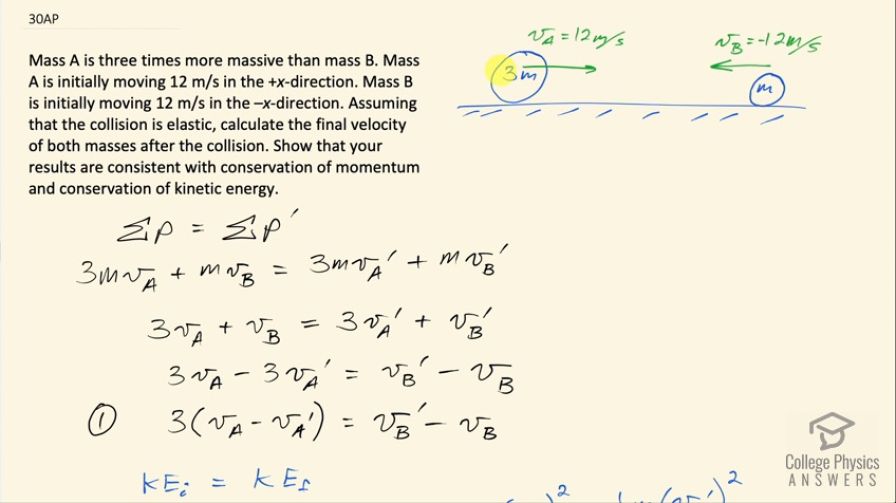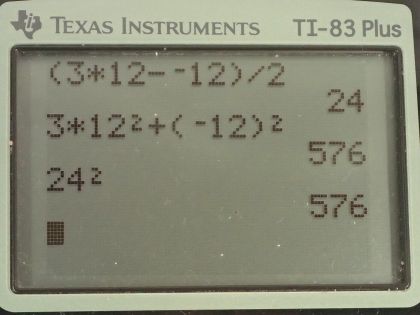Question
Mass A is three times more massive than mass B. Mass A is initially moving 12 m/s in the +x-direction. Mass B is initially moving 12 m/s in the –x-direction. Assuming that the collision is elastic, calculate the final velocity of both masses after the collision. Show that your results are consistent with conservation of momentum and conservation of kinetic energy.
Final Answer
Yes, both momentum and kinetic energy are conserved.
Solution video
OpenStax College Physics for AP® Courses, Chapter 8, Problem 30 (Test Prep for AP® Courses)

vote with a rating of
votes with an average rating of
.
Calculator Screenshots
Video Transcript
This is College Physics Answers with Shaun Dychko. Mass A is moving in the positive x-direction with a speed of 12 meters per second and it has a mass of 3m or 3 times the mass of whatever this other thing is... object B. So object B has a mass m and its speed is 12 meters per second but it's moving to the left so we are gonna say velocity of B is going to be negative 12 meters per second. We know that momentum is going to be conserved in this collision which we are told is an elastic collision which is to say that the kinetic energy also is conserved when you see the word elastic. We are going to find the final velocity of both masses after the collision. Now given that total momentum is conserved, we first look at the total momentum initially before collision and then equate that to the total momentum after collision. So the momentum of mass A is 3m times velocity of mass A and the m does not need a subscript A because we are going to write the masses in terms of mass B, mass B being m and mass A being 3 times whatever mass B is—m— and so we can write it this way and this is useful because the m will cancel on both sides. The initial momentum of mass B is m times velocity B and then after collision, it's 3m times velocity A after collision and the after is indicated by this prime and then the momentum of mass B is m times v B prime. Okay! So we divide both sides by m and then we have 3v A plus v B equals 3v A prime plus v B prime and I am going to rewrite this a little bit differently and at this point, it won't make any sense why I am doing this but it will make sense later after we deal with this conservation of kinetic energy. So I am going to write 3v A prime minus on both sides so minus 3v A prime on both sides and then also minus v B on both sides. So on the left side, we have 3v A minus 3v A prime and on the right hand side, we have v B prime minus v B. Okay! And we can factor out the 3 here so it's 3 times v A minus v A prime equals v B prime minus v B; doing this movement of terms around between sides is strategic for what follows next. So kinetic energy is conserved since the collision is elastic that means one-half times the mass of object A, which is 3m times the velocity of object A squared plus one-half mv B squared— that's the total initial kinetic energy— it's going to equal the total final kinetic energy all the terms are the same except we have a prime here to indicate using velocities after the collision. We can divide both sides by one-half m and we are left with 3v A squared plus v B squared equals 3v A prime squared plus v B prime squared and then we are going to rearrange terms for a reason that remains mysterious for one more line and then I will reveal the explanation for this in a moment and so we are gonna minus 3v A prime from both sides... squared I should say (3v A prime squared) and then minus v B squared from both sides and on the left side, after factoring out the common factor 3, we have 3 times v A squared minus v A prime squared and on the right hand side, we have v B prime squared minus v B squared and this is the difference of squares— this is a difference between two terms that are each squared— and there's a pattern for factoring this which is to write it as v B prime minus v B multiplied by v B prime plus v B and if you were to work out, you know, first times first, first times last, and so on and so on and you multiply all the terms through here, you will end up with v B prime squared minus v B squared. Okay! And the same factoring pattern has been applied to the left side so we have 3 times v A minus v A prime times v A plus v A prime and we'll call this equation number two. And if we take equation two and divide it by equation one, we'll see that some nice things happen and this is the reason why we moved the terms around— why we moved terms around such that we have a difference of squares— we wanted that so that we could factor it so that we could divide this equation by the equation we found using momentum up here. And so on the left side, we have 3v A minus v A prime in the denominator here or you are dividing equation two by equation one and these factors will cancel with these factors leaving us with v A plus v A prime on the left and on the right hand side, we can divide by v B prime minus v B, which is a term that showed up after factoring and so those terms cancel leaving us with v B prime plus v B and so we have a third equation. Well, I mean I've been labeling it equation number three, this is the second equation of the two linear simultaneous equations that we are going to solve and I say linear because they have exponents one, which are way easier to work with than equations with exponents two so we wanted to change this kinetic energy formula into an equation that had v B... or the speeds to the power of one so that we could solve them more easily. So taking equation three and rewriting it as v A prime equals v B prime plus v B minus v A which I did by just subtracting v A from both sides there, this will get substituted into equation number one from conservation of momentum. So I am rewriting equation one but substituting for v A prime and I did that in red here replacing it with v B prime plus v B minus v A and we are subtracting this whole bracket so this v A becomes positive because we are subtracting a negative and that accounts for the 2v A here and then minus v B prime minus v B. Okay! And then multiply through by 3 and we have 6v A minus 3v B prime minus 3v B equals v B prime minus v B; we have an equation containing only one unknown now—v B prime— and we are gonna solve for it. So we'll add 3v B prime to both sides and then add v B to both sides and switch the sides around and we have 4v B prime equals 6v A minus 2v B. Then we can divide both sides by 4 and then reducing that gives 3v A minus v B over 2. So that's 3 times 12 meters per second— the initial velocity of mass A— minus the initial velocity of mass B, which was negative 12 meters per second so that minus and negative makes a positive by the way all that divided by 2 gives us 24 meters per second positive is going to be the velocity of mass B after the collision. Then we take that answer and substitute it into equation 3b so this is equation 3b and we are gonna replace v B prime now that we know it and so v A prime is 24 meters per second plus negative 12 meters per second— the initial velocity of object B— minus 12 meters per second—the initial velocity of object A— and that gives us 0 meters per second. So mass A just suddenly stops after colliding with mass B. So mass A comes along and there's a collision here and at this point, the velocity of object A will be zero and object B will be zipping off to the right with a velocity of positive 24 meters per second. Okay! Good! So then we have to confirm that momentum is conserved so we can return to our momentum conservation formula that we had before... equation I should say... and then replace the speeds with the numbers that we have discovered. So we have zero for v A prime and we have 24 for v B and we can see that the left side equals the right side 3 times 12 plus negative 12 makes 24 on the left and on the right side, we have 3 times 0 plus 24 is 24 and so yes, momentum is conserved since the left side equals the right side. Then we have to take the total kinetic energy initially and see if that equals the total kinetic energy final and I have canceled common factors of one-half m from each of these terms here. So we have 3 times 12 squared plus negative 12 squared that equals 576 meters squared per second squared— units don't really matter here but I am just writing them anyway— and on the right hand side, we have 0 in place of v A prime and 24 in place of v B prime and this also is 576 and so yes, kinetic energy is conserved since the total initial equals the total final.
